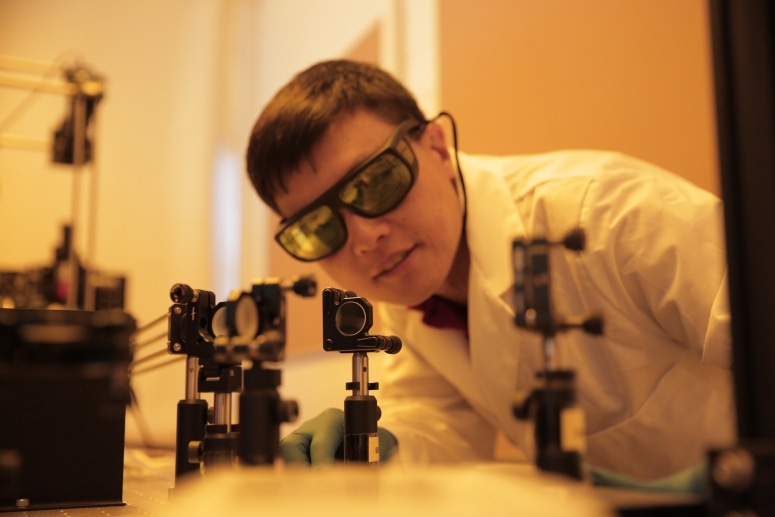Aug 5 2016
 Hongrui Jiang inspects the alignment of a light source to illuminate new-generation lateral solar cells. The solar cells developed by Jiang’s group harvest almost three times more electricity from incoming light as compared to existing technologies. PHOTO: STEPHANIE PRECOURT
Hongrui Jiang inspects the alignment of a light source to illuminate new-generation lateral solar cells. The solar cells developed by Jiang’s group harvest almost three times more electricity from incoming light as compared to existing technologies. PHOTO: STEPHANIE PRECOURT
Engineers at the University of Wisconsin-Madison have developed small yet high-performance solar cells that exceed similar devices in terms of critical performance parameters.
The micro-scale solar panels are capable of powering a wide range of personal devices, such as wearable smart watches, medical sensors, as well as auto focusing contact lenses. The results of the study have been described in the journal, Advanced Materials Technologies.
Rooftop photovoltaic arrays create electricity from vertically moving charges. The miniature solar cells capture electricity from charges traveling either laterally or side-to-side and create more amount energy as opposed to other sideways solar systems.
The new, advanced lateral solar cells could set a new benchmark for compact-sized devices because the horizontal arrangement of electrodes enables engineers to skip a conventional solar cell fabrication process, where many layers of the cell’s material have to be perfectly aligned on top of one another. However, with lateral solar cells, engineers also get more flexibility in choosing materials.
From a fabrication point of view, it is always going to be easier to make side-by-side structures. Top-down structures need to be made in multiple steps and then aligned, which is very challenging at small scales.
Hongrui Jiang, Professor, UW–Madison
Top-down photovoltaic cells include a pair of electrodes that surround a semiconducting material, just like bread slices placed around the meat in a sandwich. When the top slice is bombarded with light, the charge passes through the filling to the base layer and generates electricity.
With regard to the top-down arrangement, a single layer has to perform two tasks - it must allow light and transfer charge. As a result, in any standard solar cell, the material for one electrode should be highly transparent and electrically conductive. However, only a few materials can execute these tasks suitably.
Jiang’s team developed a tightly packed, side-by-side array of tiny electrodes on top of the transparent glass, instead of sandwiching multiple layers of the solar cell atop one another. The resulting structure is like solar-cell sandwiches standing in a sideway manner on a plate similar to slices of bread’s, separating charge-conducting and light-harvesting functions between the two components.
As a rule, it is not easy to create these sideways sandwiches. Other methods relying on expensive materials known as perovskites or complex internal nanowires do not meet the various parameters of solar cell quality.
“We easily beat all of the other lateral structures,” says Jiang.
In current top-of the-line lateral solar cells, just 1.8% of incoming light is converted into electric current, but Jiang’s team almost tripled that measure, accomplishing an efficiency of 5.2%.
In other structures, a lot of volume goes wasted because there are no electrodes or the electrodes are mismatched. The technology we developed allows us to make very compact lateral structures that take advantage of the full volume.
Hongrui Jiang, Professor, UW–Madison
The devices’ “fill factors” were considerably increased by packing multiple electrodes into a small volume. Fill factors are a metric associated with the highest attainable current, voltage, and power. The side-by-side structures accomplished up to 0.6 fill factors, which were more than double the maximum for other top-of the-line, lateral new-generation solar cells.
Jiang’s group is exploring other materials to make the new solar cells more efficient and smaller, and thus further improve conductivity and transparency. The researchers are planning to design flexible and tiny solar cells that could power an electrically adjustable contact lens.
Other authors of the paper include Yinggang Huang, Xi Zhang, Hewei Liu, Hao Bian, and Xuezhen Huang. The research was funded by the National Institutes of Health.